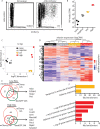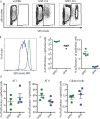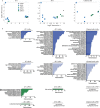Cell type- and replication stage-specific influenza virus responses in vivo
- PMID: 32790753
- PMCID: PMC7447048
- DOI: 10.1371/journal.ppat.1008760
Cell type- and replication stage-specific influenza virus responses in vivo
Abstract
Influenza A viruses (IAVs) remain a significant global health burden. Activation of the innate immune response is important for controlling early virus replication and spread. It is unclear how early IAV replication events contribute to immune detection. Additionally, while many cell types in the lung can be infected, it is not known if all cell types contribute equally to establish the antiviral state in the host. Here, we use single-cycle influenza A viruses (scIAVs) to characterize the early immune response to IAV in vitro and in vivo. We found that the magnitude of virus replication contributes to antiviral gene expression within infected cells prior to the induction of a global response. We also developed a scIAV that is only capable of undergoing primary transcription, the earliest stage of virus replication. Using this tool, we uncovered replication stage-specific responses in vitro and in vivo. Using several innate immune receptor knockout cell lines, we identify RIG-I as the predominant antiviral detector of primary virus transcription and amplified replication in vitro. Through a Cre-inducible reporter mouse, we used scIAVs expressing Cre-recombinase to characterize cell type-specific responses in vivo. Individual cell types upregulate unique sets of antiviral genes in response to both primary virus transcription and amplified replication. We also identified antiviral genes that are only upregulated in response to direct infection. Altogether, these data offer insight into the early mechanisms of antiviral gene activation during influenza A infection.
Conflict of interest statement
The authors have declared that no competing interests exist.
Figures






References
-
- York A, Hengrung N, Vreede FT, Huiskonen JT, Fodor E. Isolation and characterization of the positive-sense replicative intermediate of a negative-strand RNA virus. Proceedings of the National Academy of Sciences of the United States of America. 2013;110(45):E4238–45. 10.1073/pnas.1315068110 - DOI - PMC - PubMed
Publication types
MeSH terms
Substances
Grants and funding
LinkOut - more resources
Full Text Sources
Medical
Molecular Biology Databases

